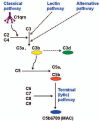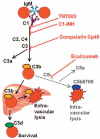Role of Complement in Autoimmune Hemolytic Anemia
- PMID: 26696798
- PMCID: PMC4678321
- DOI: 10.1159/000438964
Role of Complement in Autoimmune Hemolytic Anemia
Abstract
The classification of autoimmune hemolytic anemias and the complement system are reviewed. In autoimmune hemolytic anemia of the warm antibody type, complement-mediated cell lysis is clinically relevant in a proportion of the patients but is hardly essential for hemolysis in most patients. Cold antibody-mediated autoimmune hemolytic anemias (primary cold agglutinin disease, secondary cold agglutinin syndrome and paroxysmal cold hemoglobinuria) are entirely complement-mediated disorders. In cold agglutinin disease, efficient therapies have been developed in order to target the pathogenic B-cell clone, but complement modulation remains promising in some clinical situations. No established therapy exists for secondary cold agglutinin syndrome and paroxysmal cold hemoglobinuria, and the possibility of therapeutic complement inhibition is interesting. Currently, complement modulation is not clinically documented in any autoimmune hemolytic anemia. The most relevant candidate drugs and possible target levels of action are discussed.
Keywords: Autoimmune hemolytic anemia; Cold agglutinin disease; Complement; Complement inhibitors; Therapy.
Figures





References
-
- Dacie J. The auto-immune haemolytic anaemias: introduction; in Dacie J (ed): The Haemolytic Anaemias, Vol. 3. London, Churchill Livingstone, 1992, pp 1-5.
-
- Michel M. Classification and therapeutic approaches in autoimmune hemolytic anemia: an update. Expert Rev Hematol. 2011;4:607–618. - PubMed
-
- Packman CH. Hemolytic anemia due to warm autoantibodies. Blood Rev. 2008;22:17–31. - PubMed
-
- Berentsen S, Tjonnfjord GE. Diagnosis and treatment of cold agglutinin mediated autoimmune hemolytic anemia. Blood Rev. 2012;26:107–115. - PubMed
Publication types
LinkOut - more resources
Full Text Sources
Other Literature Sources

